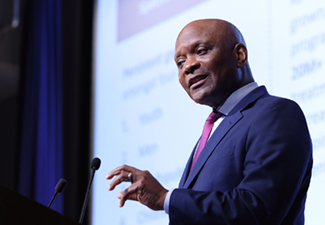Nkengasong delivers warning in Barmes Lecture 2024
July 5, 2024
By Susan Scutti
 Photo credit: Chia-Chi Charlie Chang/NIHNIH Director Dr. Monica Bertagnolli conducted a "fireside" Q&A with the ambassador.
Photo credit: Chia-Chi Charlie Chang/NIHNIH Director Dr. Monica Bertagnolli conducted a "fireside" Q&A with the ambassador.
When asked by NIH Director Dr. Monica Bertagnolli what keeps him up at night, Ambassador Dr. John Nkengasong, presenter of the 2024 NIH Barmes Global Health lecture, answered unhesitatingly: “The threat of financial challenges … I fear that HIV fatigue can kick in, complacency can kick in, and if it does the gains we’ve made may be quickly eroded.” Nkengasong recalled the
malaria eradication program the WHO initiated in 1955. It achieved some success though not as much as hoped. The turning point arrived in 1969. “The countries that had made gains saw a resurgence of malaria, and global interest faded.” Financial support dwindled soon after, said Nkengasong. Their onstage Q&A at the National Institutes of Health’s Natcher Conference Center followed Nkengasong’s delivery of the
David E. Barmes Global Health Lecture 2024.
First Barmes lecture since pandemic
Dr. Jennifer Webster-Cyriaque, acting director, National Institute of Dental and Craniofacial Research (NIDCR), provided introductory remarks for the lecture. The speaker was Dr. John Nkengasong, U.S. Global AIDS Coordinator and Senior Bureau Official for Global Health Security and Diplomacy—a role which includes leading the
U.S. President’s Emergency Plan for AIDS Relief (PEPFAR). He started by describing key moments in his career. He joined the fight against HIV in 1988 and also helped with the responses to the Western Africa Ebola epidemic and the COVID-19 pandemic. Each crisis required a focus on the Five P’s of pandemic preparedness, he said. “We need to know the pathogen. We need to know the population. We need to know the policies. We need to know the politics and we need to know the partnerships.”
Next he highlighted PEPFAR's achievements. In 2012, most PEPFAR-supported African countries reported less than 60% of people living with HIV on ART (antiretroviral treatment); a decade later, many countries are above 80% coverage. AIDS-related deaths have declined 68% since their peak in 2004, while new infections are down 42%. PEPFAR has saved 25 million lives and 5.5 million babies have been born free of HIV thanks to the program.
Overall, the rate of new infections has plummeted, but “we're not out of the woods,” warned Nkengasong. PEPFAR’s strategy to accomplish its 2030 goal of decreasing HIV infections by 90% compared to 2010 focuses on 95-95-95: 95% of people who are infected know their status; 95% of people with HIV are in treatment; and 95% of those in treatment are suppressed. When the three 95s are achieved, the epidemic will come under control, said Nkengasong. “I believe in that metric strongly—it gives us a north star.”
Current and future challenges
 Photo credit: Chia-Chi Charlie Chang/NIHAmbassador Dr. John Nkengasong presented the David E. Barmes Global Health Lecture, warning of "HIV fatigue" setting over the global response to the epidemic.
Photo credit: Chia-Chi Charlie Chang/NIHAmbassador Dr. John Nkengasong presented the David E. Barmes Global Health Lecture, warning of "HIV fatigue" setting over the global response to the epidemic.
PEPFAR’s progress, though widespread, is uneven across the globe. “We have a series of countries—Kyrgyz Republic, Tajikistan, Papua New Guinea, and the Philippines—that we characterize as ‘epidemics of concern,’ countries where we see incidence increasing.” In all regions, key drivers of transmission include people with undiagnosed HIV, those diagnosed but never treated, and those who interrupt treatment. Studies have begun to show viral resistance to medications, which is exacerbated when people “cycle in and out of treatment.” Meanwhile, the 15-24 year-old age group accounts for 27% of new infections globally. “We have to pay attention and use all kinds of behavior science, interventions and approaches to try to bring [people] to care and make sure they stay in care,” stated Nkengasong. Data must be used “in a more granular fashion” to identify and close gaps.
He envisions a future where the HIV/AIDS response transitions from an infectious disease crisis to a disease management strategy. “We’ve put a lot of emphasis on PrEP [pre-exposure prophylaxis],” said Nkengasong. PEPFAR has introduced long-acting PrEP in four countries (Malawi, Ukraine, Zambia, and Zimbabwe), and by year-end, 12 countries in total will be receiving treatment supplies. Though hopeful, Nkengasong reminded the audience of more than 450 (in-person and virtual) attendees of the danger that HIV can get pushed to the background whenever other emerging diseases, such as COVID-19 or mpox, arise.
Meanwhile, the HIV response is at a crossroads: “We need to think about financing, we need to finish the fight,” said Nkengasong. “If PEPFAR was to stop today, you’d have an almost 400% increase in death rates.”
A version of this story was first published in the NIH Record:
Ambassador Nkengasong Discusses Global HIV/AIDS Response.
More information
Updated July 15, 2024
To view Adobe PDF files,
download current, free accessible plug-ins from Adobe's website.
Related Global Health Research Topics